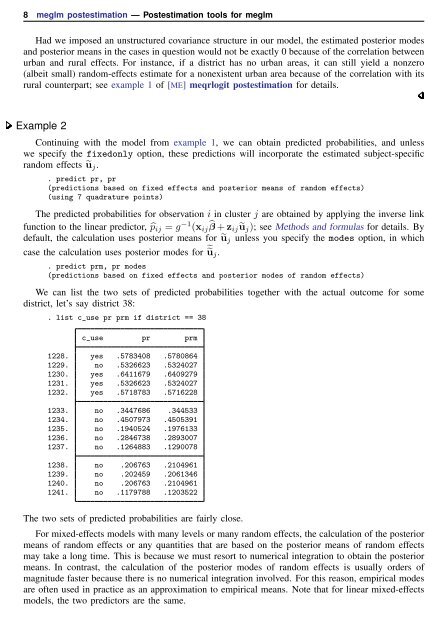meglm postestimation - Stata
meglm postestimation - Stata
meglm postestimation - Stata
Create successful ePaper yourself
Turn your PDF publications into a flip-book with our unique Google optimized e-Paper software.
8 <strong>meglm</strong> <strong>postestimation</strong> — Postestimation tools for <strong>meglm</strong><br />
Had we imposed an unstructured covariance structure in our model, the estimated posterior modes<br />
and posterior means in the cases in question would not be exactly 0 because of the correlation between<br />
urban and rural effects. For instance, if a district has no urban areas, it can still yield a nonzero<br />
(albeit small) random-effects estimate for a nonexistent urban area because of the correlation with its<br />
rural counterpart; see example 1 of [ME] meqrlogit <strong>postestimation</strong> for details.<br />
Example 2<br />
Continuing with the model from example 1, we can obtain predicted probabilities, and unless<br />
we specify the fixedonly option, these predictions will incorporate the estimated subject-specific<br />
random effects ũ j .<br />
. predict pr, pr<br />
(predictions based on fixed effects and posterior means of random effects)<br />
(using 7 quadrature points)<br />
The predicted probabilities for observation i in cluster j are obtained by applying the inverse link<br />
function to the linear predictor, ̂p ij = g −1 (x ij ̂β + zij ũ j ); see Methods and formulas for details. By<br />
default, the calculation uses posterior means for ũ j unless you specify the modes option, in which<br />
case the calculation uses posterior modes for ũ j .<br />
. predict prm, pr modes<br />
(predictions based on fixed effects and posterior modes of random effects)<br />
We can list the two sets of predicted probabilities together with the actual outcome for some<br />
district, let’s say district 38:<br />
. list c_use pr prm if district == 38<br />
c_use pr prm<br />
1228. yes .5783408 .5780864<br />
1229. no .5326623 .5324027<br />
1230. yes .6411679 .6409279<br />
1231. yes .5326623 .5324027<br />
1232. yes .5718783 .5716228<br />
1233. no .3447686 .344533<br />
1234. no .4507973 .4505391<br />
1235. no .1940524 .1976133<br />
1236. no .2846738 .2893007<br />
1237. no .1264883 .1290078<br />
1238. no .206763 .2104961<br />
1239. no .202459 .2061346<br />
1240. no .206763 .2104961<br />
1241. no .1179788 .1203522<br />
The two sets of predicted probabilities are fairly close.<br />
For mixed-effects models with many levels or many random effects, the calculation of the posterior<br />
means of random effects or any quantities that are based on the posterior means of random effects<br />
may take a long time. This is because we must resort to numerical integration to obtain the posterior<br />
means. In contrast, the calculation of the posterior modes of random effects is usually orders of<br />
magnitude faster because there is no numerical integration involved. For this reason, empirical modes<br />
are often used in practice as an approximation to empirical means. Note that for linear mixed-effects<br />
models, the two predictors are the same.
















